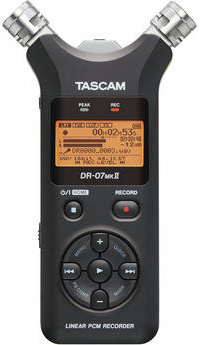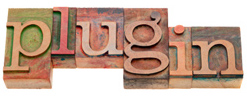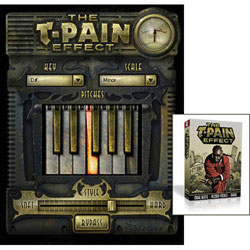
B&H Pro Audio has a great deal on the Tascam DR-07mkII Portable Digital Audio Recorder right now. The regular price is $149.99, and the sale price is $119.99, the lowest price on the internet!
The reasons that this portable/mobile audio recorder is so awesome include its ability to adjust the two microphones for different stereo recording configurations (X/Y or A/B), as well as the fact that it records both high-quality WAV (16 and 24-bit) or MP3 (32-320 kbps VBR) formats.
It’s perfect for recording interviews, rehearsals, sound-design elements (like sound effects you’d use in video/movie projects), or live music shows. It has a 3.5mm stereo mic/line input so you could record the output of a mixer (great for live performances). It also has the same sized (3.5mm) stereo output (headphone/line) so you can connect additional equipment, even speakers. You can transfer recordings via its mini USB 2.0 port or the microSD or microSDHC cards it records on. IT runs on 2 standard AA batteries, or by USB bus power, or from a USB AC wall adapter.
It is always handy to have a pocket-sized digital recorder and now you can get this awesome one for a huge discount. To get yours, or find out more, CLICK HERE.
Home Recording Equipment
Don't Forget About These Pro Tools Stock Plugins
Sometimes when you get something for free, especially if it’s part of a package, you may not value it as much – or you may forget about it entirely. Pro Tools, the industry standard DAW (which stands for digital audio workstation – a fancy way of saying multi-track recording software) comes with a lot of plug-ins, for both effects and virtual instruments.
Here is an article by Graham, identifying three oft-overlooked, but very useful stock plugins.
- The AIR Fuzz-Wah
- The Avid Lo-Fi plugin
- dVerb
See Graham’s article about them here: http://therecordingrevolution.com/2012/08/10/3-underrated-stock-pro-tools-plugins/
VST Plugins – Add Effects and Virtual Instruments to Your Home Studio
 If you are not already with VST plugins, let me enlighten you at once. Your home studio software program probably came with at least some effects built-in, such as compression, EQ, or maybe a reverb effect. But sooner or later you’ll probably want to add to that initial collection of effects. Enter, VST, which stands for Virtual Studio Technology. It was invented by Steinberg, maker of excellent audio recording software and hardware, who hold the trademark for VST technology. But that’s not the stuff you want to know, is it?
If you are not already with VST plugins, let me enlighten you at once. Your home studio software program probably came with at least some effects built-in, such as compression, EQ, or maybe a reverb effect. But sooner or later you’ll probably want to add to that initial collection of effects. Enter, VST, which stands for Virtual Studio Technology. It was invented by Steinberg, maker of excellent audio recording software and hardware, who hold the trademark for VST technology. But that’s not the stuff you want to know, is it?
VST Effect Plugins
The most common use of VST is to add effects to tracks in your DAW, or to add editing tools to your editor. 3rd-party developers sell these effect plugins for lots of different effects like chorus, flanger, delay, filters, EQ, compressors, limiters, noise reduction, tuning effects like Auto-Tune, just to name a very few. A search on B&H Pro Audio’s website for VST Effects brings up 73 different items! One reason to use these plugins rather than, or in addition to the built-in effects on your software is that a plugin developer has designed their product with nothing else in mind, so the quality of the resulting effect is likely to be much better than one of a collection in a bundle that was a bonus to your recording program. And as I already hinted at, the sheer variety and volume of selection is another reason to use VST plugins.
Virtual Instruments
I’ve discussed virtual instruments here many times. They give us the ability to add realistic sounding drums, horns, pianos, harps, violins (do I need to go on?), etc. to our recordings without having to actually have the physical instrument. Neither do we need to have a person to play said instrument. All we need is a MIDI keyboard. Heck, if our recording software has a MIDI editor (Reaper does;)), all we need to do is draw in MIDI notes and when we hit the “play” button, the MIDI data will play the instrument. A search on the B&H site for VSTi returned 31 different results. And several of these were not just single instruments but collections or packages of instruments. For example, the Garritan Virtual Marching Band VSTi contains dozens of instruments including individual and grouped trumpets, trombones, tubas, cornets, piccolos, oboes, clarinets, and the full range of drums and other percussion instruments you’d find in a drum line. This is just one package from one developer.
How To Use VST/VSTi
Installing a VST or VSTi will place a dll file on your computer (usually into a folder called “Steinberg/VST” even if you don’t have any Steinberg programs). Most recording programs search your directories for VST or VSTi files (dll type) when they open, so you probably won’t have to do anything. The effect or instrument will just be available to you once inside your DAW.
Most DAWs work the same way. For effects, you simply click on the “FX” (in Reaper) or similar button on a track control, and choose your VST effect. Then that effect will be applied to your audio.
For instruments, it’s pretty much the same except that the track will need to be a MIDI track. Then whatever notes the MIDI data play will be heard as played on the instrument you loaded up.
So that’s it in a nutshell. Adding professional effects or virtual instruments is fast and easy and can really raise the beam on the quality of your recordings.
Cheers!
T-Pain Vocal Recording Software
 No doubt you have heard the use of tuning software (usually Auto-Tune) used not as a tool for correcting the pitch of a singer’s recording, but as an effect in and of itself to make a voice sound unnatural and “computery.” There is a hip-hop artist out there whose name is becoming synonymous with this kind of thing, and he is known as T-Pain.
No doubt you have heard the use of tuning software (usually Auto-Tune) used not as a tool for correcting the pitch of a singer’s recording, but as an effect in and of itself to make a voice sound unnatural and “computery.” There is a hip-hop artist out there whose name is becoming synonymous with this kind of thing, and he is known as T-Pain.
Now there is a tool you can buy (instant download) called The T-Pain Effect, by iZotope, that will allow you to not only apply the extreme tuning effect to your voice, but also to do beat-making using the virtual drum machine that comes with it.
There are 3 music-making tools designed for beginners (you don’t need to know much, if anything, about audio recording) that allow you to arrange beats, record your voice, and in just a matter of minutes, post your tracks on-line.
Click here or on the picture to buy it and download it right now.
Calibrating Your Amplifiers
Here is an article from AudioTuts Premium about calibrating your amplifiers. The post goes into why it’s important to understand the innards of gear like amplifiers in order to get the best sound. Understanding leads to the ability to trouble-shoot problems and/or simply get the best sound possible by tweaking here and there.
As I mentioned, this is one of the AudioTut Premium tutorials, so though you can read the abstract and some quotes if you’re not a member, you’ll need to be a member to read the full article here:
http://audio.tutsplus.com/articles/general/understanding-and-calibrating-your-system-amplifiers-tuts-premium/